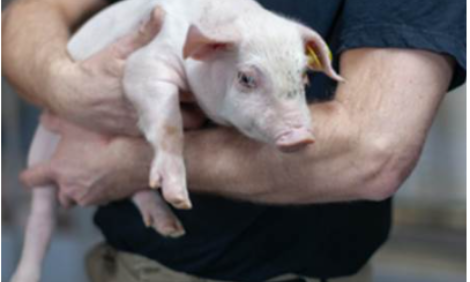



Emerging Threats Quarterly Report – Pig Diseases – October-December 2014
Among the significant developments reported in Great Britain were diseases associated with deficient home-mix diets, a continued upward trend in PRRS and the first diagnosis of oedema disease in East Anglia this decade. There is also an update on outbreaks of Porcine Epidemic Diarrhoea in Europe.Highlights
These reports aim to identify emerging animal disease related threats. Their production is underpinned by a large amount of surveillance data and information compiled as part of the Defra Food and Farming Group animal disease surveillance programme. Some of these data can be viewed on the APHA web site.
- Outbreaks of Porcine Epidemic Diarrhoea in Europe
- Unusual diseases associated with deficient home-mix diets
- Upward trend in PRRS diagnoses continues
- First diagnosis of oedema disease in East Anglia this decade.
New and Emerging Diseases
Outbreaks of Porcine Epidemic Diarrhoea in Europe
There have been significant developments in Europe relating to PED outbreaks. The EFSA Scientific Opinion on porcine epidemic diarrhoea virus (PEDv) was published in October 2014 (EFSA, 2014). This described outbreaks of PED in Italy and Germany in 2014, from which the virus strains characterised were shown to be similar to each other, clustering genetically with a strain known as OH851, found in the United States in 2014 and reported to be associated with milder disease. Hanke and others (2014) report details of a German PED virus similar to OH851 and distinct from those described as highly virulent PEDV strains which cause severe piglet mortality in North America and Asia.
Between October and December 2014, two more countries in Western Europe (France and the Netherlands) saw their first outbreaks of PED. Anecdotal information from outbreaks in Western Europe from which virus has been characterised indicates that they are also due to PEDv showing high nucleotide similarity to strain OH851.
The original source of infection with the PEDv strain in Western Europe is not currently known and could be due to new introduction(s) from outside Europe, spread from somewhere undisclosed elsewhere in Europe or re-crudescence from low level infection. Some of the outbreaks are known to be have pig transport vehicle links.
Clinical signs, even in postweaned growing pigs, have been distinctive with very high morbidity reported at all ages. Rapidly spreading and transient profuse diarrhoea of virtually 100 per cent morbidity is not common at any age so these clinical signs are a good early warning. Pigs may show some lethargy and inappetance also. However, veterinarians involved in outbreaks point out that differential diagnoses (Lawsonia, salmonellosis, Escherichia coli and possibly, swine dysentery or pilosicoli colitis) should be considered in post-weaned pigs and could occur concurrently, as the clinical appearance is not pathognomonic.
Mortality in sucking pigs in Western Europe (with the strain similar to OH851 strain of PED) has been variable and not always high – concurrent infections, secondary infections and care given to piglets appear to be important factors affecting mortality.
In a separate development, in December 2014, a PED outbreak ongoing since summer of 2014, was unofficially reported in the Ukraine on a pig breeding unit. This outbreak clinically resembled the highly virulent PED outbreaks described in the United States and this impression was supported by virus characterisation identifying virus as similar to strains found in severe PED outbreaks in North America and Asia, and not clustering with strain OH851. Vomiting was a distinct feature in pigs including finishers in the Ukraine outbreak, which was not reported in Western Europe outbreaks.
This has raised significant concern, especially with respect to potential spread into Eastern EU countries. It is vital that strict biosecurity measures are implemented and maintained to keep the infection out of the country and out of pig farms and that pig keepers and their attending veterinary surgeons are aware of the clinical signs of PEDv.
As part of surveillance to ensure prompt detection of a PED outbreak, BPEX is contributing funding for APHA to test diagnostic samples from outbreaks of diarrhoea in pigs for PEDv by PCR; 168 submissions have been tested since June 2013 and no PEDv has been detected.
The industry contingency plan for the control and elimination of PED which has now been published.
A newsletter item for practitioners was circulated in December from APHA veterinary investigation centres and to Pig Veterinary Society members. This raised awareness of the outbreaks in Europe and the need for prompt submission of faeces or intestinal contents to APHA or SACCVS from cases with suspicious signs for PEDv testing to increase the chances of early detection of PED should the virus enter the GB pig herd. Further information is available on from BPEX.
Livestock-Associated Methicillin-resistant Staphylococcus aureus (MRSA)
Livestock-associated MRSA was detected for the first time in GB pigs.
Skin disease resembling exudative epidermitis due to Staphylococcus hyicus infection (greasy pig disease) in young piglets prompted submission of two 10-day-old pigs to an APHA veterinary investigation centre for diagnosis in late December 2014. Eleven litters were affected and, of 60 piglets with the condition, six died.
Both pigs had multifocal skin lesions between 2mm to 20 mm in size, with an overlying, crusting, fibrinous exudate. Cultures of affected skin from both piglets and of lung from one piglet yielded profuse growths of Staphylococcus aureus, which was subsequently identified by further phenotypic and molecular testing as livestock-associated MRSA ST398 and this finding was reported (Hall, Kearns and Eckford, 2015). Clinical signs in the herd resolved, possibly following attention to underlying factors which may have been causing minor skin trauma or which were influencing the degree of environmental challenge.
Pigs colonised by LA-MRSA usually show no clinical signs but opportunistic staphylococcal infections such as this occasionally occur and skin disease in piglets associated with LA-MRSA has been described in the Netherlands (Van Duijkeren and others, 2007). ST398 LA-MRSA has been detected in pigs and other animals in many countries in continental Europe (EFSA 2009). A previous survey of breeding pig herds in 2008 yielded no UK samples positive for MRSA (EFSA 2009).
The letter to the Veterinary Record (Hall and others, 2015) advised people in regular close contact with LA-MRSApositive livestock to take standard hygiene precautions: covering open cuts and wounds, washing hands thoroughly after handling animals and, if undergoing medical treatment or elective surgery, informing healthcare providers of occupational exposure to livestock.
There is no legal requirement to screen animals entering the UK from countries where ST398 LA-MRSA is prevalent; however, guidance provided by the National Pig Association advises screening of live pigs before importation and this advice still stands.
On-going Investigations
Investigations into Klebsiella pneumoniae septicaemia
As expected, no outbreaks of Klebsiella pneumoniae subsp pneumoniae (Kpp) septicaemia were diagnosed in the last three months of 2014; the disease has occurred with a strict seasonal pattern since emerging. Outbreaks have been diagnosed between May and September each year since the summer of 2011.
A small study is in progress, primarily to assess different media for isolation of Kpp from faeces and to determine whether the outbreak strain (Kpp sequence type 25) is present in pigs without septicaemia – to date, the outbreak strain has only been detected in herds in which outbreaks have been diagnosed.
The antimicrobial sensitivity of Kpp isolates obtained will also be assessed alongside that of other members of the Enterobacteriaceae family isolated from the same pigs. This work is taking place alongside whole genome sequencing of outbreak isolates to help further the understanding of the Kpp strain involved with disease.
Unusual Diagnoses or Presentations
There were a number of unusual diagnoses this quarter; details of these have been included in monthly APHA or SACCVS reports. These will be kept under review to assess whether they justify initiation of emerging disease investigations.
Piglet deformities on an outdoor breeding unit
The occurrence of 40 deformed piglets across about 25 litters in a batch of farrowing sows on an outdoor unit was investigated when two were submitted to Bury St Edmunds. One to two piglets were deformed in each of the affected litters which were from any parity of sow. A few deformed piglets had also been seen in each of the previous two farrowing batches. The two submitted piglets had different deformities as illustrated in Figures 3 and 4.
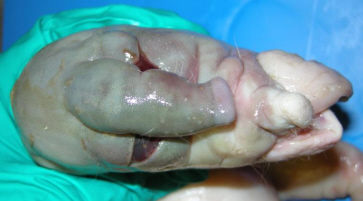
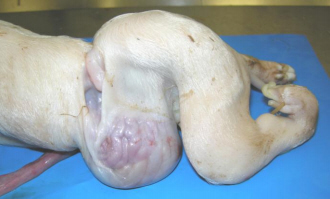
The findings in the piglet with cyclopia and a proboscis represent a severe form of holoprosencephaly (malformations of midline of prosencephalon and related facial/ocular anomalies) which is a recognised malformation syndrome in mammals and has been recorded previously in pigs as far back as 1908. It is usually a sporadic event in pigs.
The malformation in this piglet will have occurred prior to day 16 of gestation. The timing is not suggestive of involvement of an infectious agent. Teratogenic effects are recorded in the foetuses of ewes that have grazed on Veratrum californicum (California corn lily, white or California false hellebore) in North America, and exposure to certain teratogenic drugs and inherited genetic abnormalities can also be involved in holoprosencephaly. Histopathology on the piglet with abdominal and musculoskeletal deformity again does not suggest involvement of an infectious agent and further examinations are in progress to evaluate the exact timing of the insult.
Investigations into this transient event continue. The unit reported that only two litters had deformed piglets in the subsequent batch of sows to farrow. Cases like this are not common but postmortem examination of piglets with a range of deformities can be useful in establishing the timing of the in utero insult. A protocol has been established to assist diagnostic investigation. APHA is interested to hear about similar cases and discuss their submission for investigation. It is also useful if images of the range of deformities seen can be provided.
Unusual Diseases Associated with Deficient Home-mix Diets
Haemorrhage due to with copper deficiency in pigs on milk-based diet
Copper deficiency was diagnosed in a small herd of four-month-old pigs. Two were found dead and postmortem examination was undertaken at the fallen stock premises in the North of England where an EBLEX-funded initiative is in place. Fatal haemorrhage into the mediastinum and pericardium was found as illustrated in Figure 5 and the vet recalled previous reports in the literature of this pathology due to copper deficiency (Steenmetz and others, 2004)
As in the past case, the pigs were being reared on a dairy farm on a predominantly milk-based diet. Profound copper deficiency was confirmed when the livers were submitted (concentrations were less than 87μmol per kg dry matter, reference range 300-5;000) and, perhaps not surprisingly, one pig was also iron-deficient.
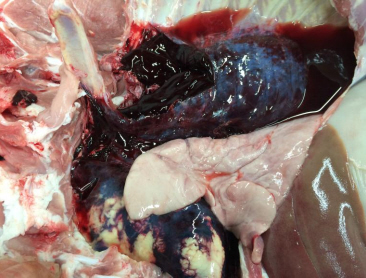
(Image kindly provided by Ben Strugnell)
Nutritional cardiomyopathy and myopathy
SACCVS diagnosed nutritional cardiomyopathy (mulberry heart disease) in a six-month-old, Gloucester Old Spot cross pig, which was the second to die on a hobby farm. Seven of the cohort of 12 were dull and intermittently pyrexic, with bright purple ears and snouts. The pigs were being fed brewer’s grains, some fruit and vegetables, sow rolls and bread without vitamin-mineral supplementation. There were abundant straw-coloured effusions with fibrin strands in the thoracic cavity and pericardial sac and the lungs showed prominent interlobular oedema (Figure 6).
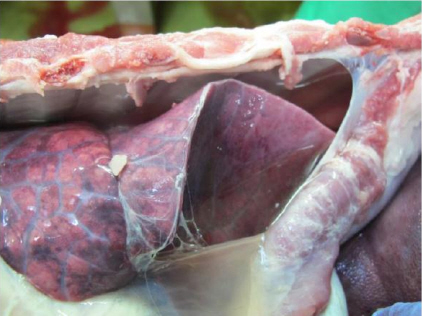
(Image kindly provided from SACCVS)
Histopathology revealed widespread myofibre degeneration in the heart. Commercial grower pig feed was introduced and pigs were supplemented with vitamin E and selenium by injection. However, seven days later, two more pigs died soon after being weighed, one showing severe respiratory distress.
Interestingly, in these pigs, histopathology revealed extensive acute myofibre degeneration with some evidence of repair in the skeletal muscle, particularly the diaphragm, but very limited pathological changes in the myocardium. It was postulated that the stress of handling induced further muscle damage and had led to respiratory failure rather than circulatory failure.
Advice was given to avoid unnecessary handling and to investigate the dose of vitamin E and selenium administered. This serves as a reminder that the full complement of tissues should be collected during post-mortem examination including skeletal muscle. Diaphragm, intercostal, gluteus and longissimus dorsi muscles are suitable for sampling.
Cases like this highlight the need to assess the diets of rapidly-growing pigs fed home-mix rations to ensure they are suitable and provide adequate vitamins, minerals and trace elements.
Changes in Disease Patterns and Risk Factors
Swine influenza diagnoses remain low over winter months
For GB, the peak diagnostic rate for swine influenza in recent years was in Q1, 2012. There was the usual seasonal Q1 peak in 2014 but this latest quarter, October to Deccember, has seen the lowest quarterly diagnostic rate since 2009 with only two incidents diagnosed. All the swine influenza incidents in 2014 were diagnosed in England and Wales, with nearly 60 per cent of the diagnoses being made in the Thirsk region.
Table 3 shows the three influenza strains identified; pandemic H1N1 2009 and H1N2 remain the most common although avian-like H1N1 is still present at a low level. Some strains are not identified, probably in part because the PCR is more sensitive than virus isolation, and also because the virus may no longer be viable in some samples.
Anecdotal reports suggest that swine influenza vaccine use has increased; nine outbreaks involved strains included in the vaccine (avian-like H1N1 and H1N2) while 11 involved pH1N109, which is not included. This demonstrates the value of determining which strain is involved in outbreaks, and thus the likely value of using the swine influenza vaccine in a herd with persistent problems.
Table 3. Swine influenza strains identified in 2014
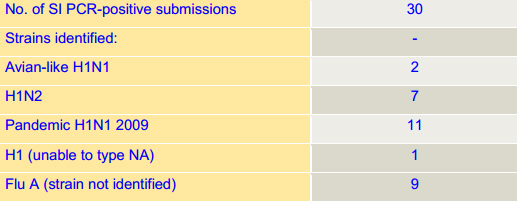
Upward trend of porcine reproductive and respiratory syndrome diagnoses
The annual trend of increased PRRS diagnoses continued in 2014 as illustrated in Figure 7. The seasonality of diagnoses is shown in Figure 8 revealing October to December 2014 (Q4) to have the highest quarterly diagnostic rate since 2004 when the PRRSv PCR was introduced, improving diagnosis. This quarterly increase was due to APHA cases.


Sixty per cent of the diagnoses in 2014 were in the Bury St Edmunds region, the numbers diagnosed in that region annually are illustrated in Figure 9 and include confirmed diagnoses in vaccinated pigs. It is generally acknowledged that the increasing diversity of PRRS viruses in the GB pig population makes it more likely that the vaccines available will not be able to fully protect against some field virus strains. It is important, when PRRS virus is detected by PCR in vaccinated pigs, follow-up investigations are undertaken to investigate the clinical significance of the detected virus – this is more feasible in pigs with respiratory or systemic disease in which PRRS immunohistochemistry is useful. Disease due to PRRS in post-weaned pigs is often associated with other pathogens or disease conditions, in part reflecting the immunosuppressive nature of the virus.
Table 4 lists the main concurrent diagnoses made with PRRS in APHA submissions in 2014 and emphasises the importance of full diagnostic investigation in these cases. Streptococcus suis, salmonellosis and pasteurellosis are the three most common diagnoses made with PRRS.
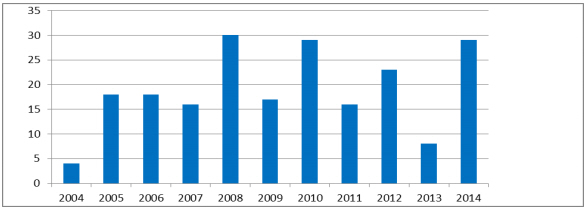
Table 4. Diagnoses concurrent with PRRS in APHA incidents in 2014
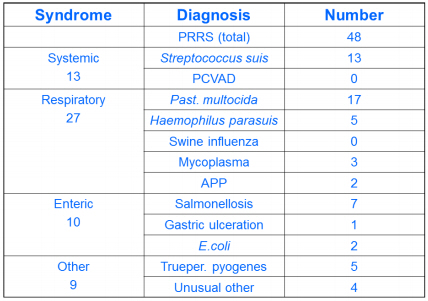
The increasing trend in PRRS diagnoses prompted a meeting at APHA Bury St Edmunds veterinary investigation centre in February 2015 to update practitioners in the region on PRRS diagnostic trends, PRRSv evolution and the use of sequencing, and PRRS control using vaccination with several case studies of PRRS incidents by practitioners. Veterinary meetings focussed on pigs are planned for later in 2015 at APHA Thirsk and Starcross veterinary investigation centres.
First diagnosis of oedema disease in East Anglia for many years
Escherichia coli disease incidents remained in 2014 as illustrated in Figure 10, mainly due to enteric disease but with more cases of oedema disease in 2014 as shown in Figure 11.

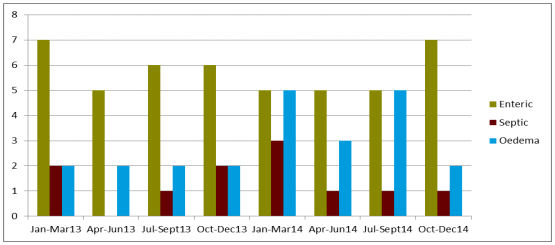
The first APHA diagnosis of oedema disease in East Anglia for many years was made in October 2014. The clinical signs of malaise, nervous signs, swollen eyes (see Figure 12) and death of 30 pigs from a group of 600 eight-week-old indoor growers over a period of a week raised suspicion of oedema disease and this was confirmed by isolation of haemolytic Escherichia coli strain E4 (serotype O139:K82) from the small intestine of affected pigs, a strain known to be associated with oedema disease.
Brain histopathology revealed multifocal asymmetric acute necrotising panencephalopathy and other histological features characteristic of oedema disease and reflecting the effect of the shiga-like toxin elaborated by the E. coli. This is the first diagnosis of oedema disease in the East Anglian region for many years. Increased diagnoses of oedema disease have been noted earlier in 2014 elsewhere in the country although the reasons for this are unclear. Oedema disease tends to affect rapidly growing pigs and feed factors including changes in diet or nutrient quality may be involved.
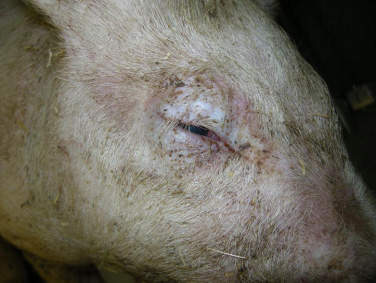
Horizon Scanning
African Swine Fever in Eastern Europe
ASF cases in wild boar continue to be reported in wild boar in Poland, Estonia, Latvia and Lithuania resulting in some changes in the restriction zones in affected Eastern EU Member States.
Early in 2015, Poland also reported an outbreak on a small backyard holding within the restricted region on the Belarus border. This is the first ASF in domestic pigs in an Eastern EU country since September 2014.
No disease has been reported from Belarus but Ukraine has had cases on the Belarus-Russia border in an area which is less affected by the fighting in the south. Additionally Russia has detected ASF in raw meat imported from Belarus. ASF has also been reported again in wild boar on the border between Ukraine and Russia. Belarus has not reported any cases of ASF since 2013 but there have been a number of unofficial reports of Belarus meat testing positive for ASF.
Russia has continued to report cases of ASF in both commercial and backyard domestic pigs and in wild boar. Information about cases reported is available from the OIE web site.
Ascaris suum as a potential zoonosis
An interesting paper from the US reporting cases of ascariasis in people in contact with infected pigs highlights the potential risk of Ascaris suum to humans (Miller and others, 2015).
Farm practices which could increase the risk of humans being exposed to to Ascaris eggs include use of pig manure as fertiliser or compost, location of pig pens near to growing garden produce and lack of regular anthelmintic treatment of pigs.
Similar cases have not been reported in Great Britain but it is worth reminding those keeping pigs of the importance of observing good personal hygiene and dedicating footwear and outer clothing to pig keeping to avoid this and other zoonotic risks.
Plant poisoning
A recent article on plant poisoning in farm animals is a useful reminder of the more likely plant toxicities which might be encountered in pigs (Payne and Murphy, 2014).
Smallholder pigs are often kept outdoors in less controlled situations than pigs in commercial herds, with access to a range of wild plants in woodland or rough grazing. Various plant poisonings have been identified in pigs including bracken (acute heart failure with lung oedema and body cavity effusions), hemlock (nervous signs or congenital deformities in piglets), bluebells and black nightshade (nervous signs).
Commercial pigs may be at risk of plant toxicity when moved to new sites and certain Umbellifera plants (parsnips, parsley) can cause contact photosensitisation.
Outbreaks of skin lesions, especially in ventral areas contacting the plants, have occurred in sows placed on fields from which these plants were cropped earlier.
Astrovirus and type AII congenital tremor
Blomström and others (2014) reported the detection of astrovirus by PCR and sequencing in the brains of piglets affected with congenital tremor (CT) type AII. This form of CT is thought to be caused by an, as yet, unidentified viral infection.
The study found astrovirus in both healthy and diseased pigs and further studies need to determine the significance of this finding in the pathogenesis of CT.
Interestingly, the study did not provide evidence to support the involvement of PCV2 in CT type AII, a possibility raised by others. In response to these findings, archived material from APHA CT type AII cases will be tested in a pan-astrovirus PCR.
Further Reading
You can view the full report by clicking here.
Find out more information on the diseases mentioned by clicking here.
March 2015







